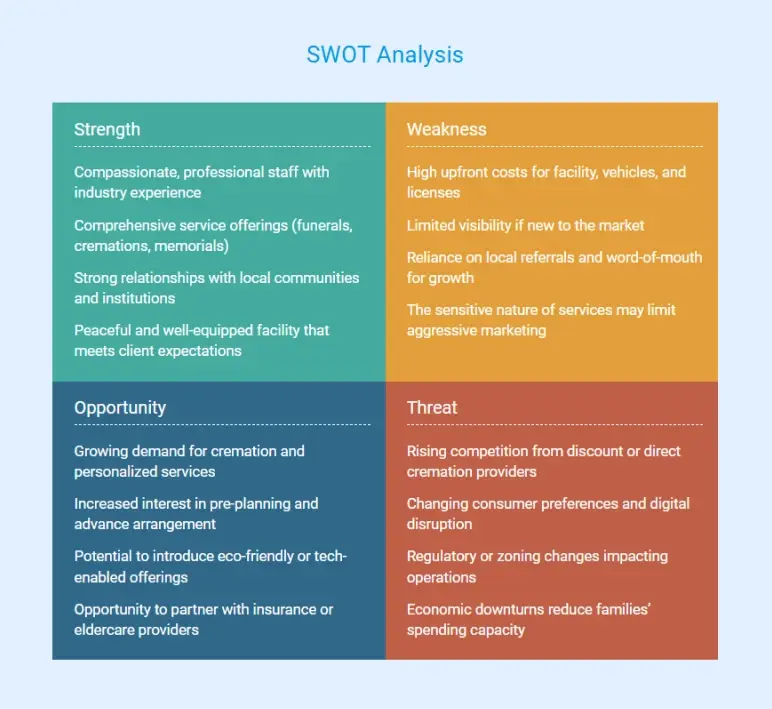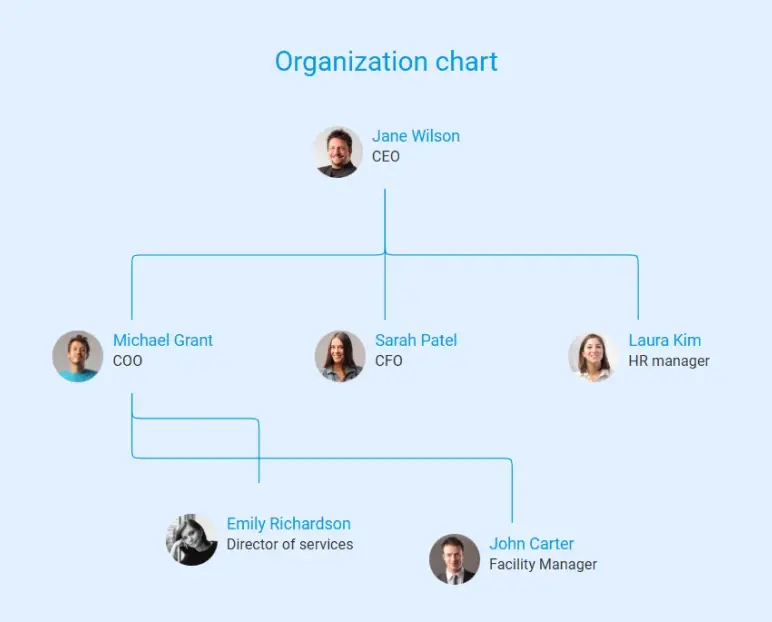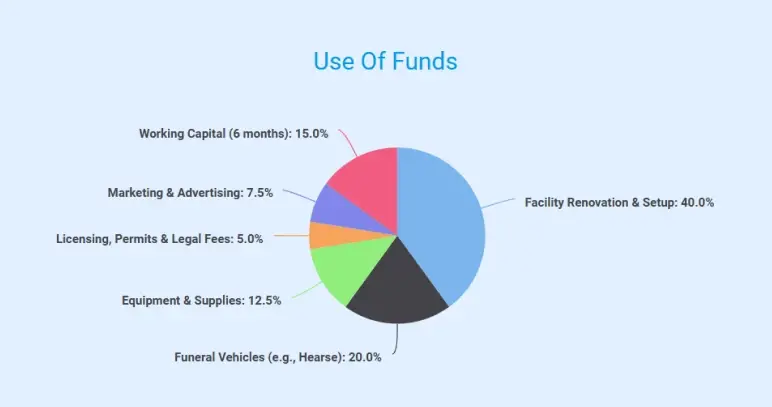Running a funeral home isn’t just about providing a needed service—it’s about showing up for people when they need it most.
But before you can do that, you need your own foundation in place. That starts with a solid business plan. It gives you a clear structure to organize your services, finances, and day-to-day decisions.
Wondering how to write a plan?
No worries! This funeral home business plan template walks you through every step of the way.
What is a funeral home business plan?
A funeral home business plan is a formal blueprint that outlines your mission, services, strategy, and financial projections. It gives details of your funeral home, its service offerings, target market, competitive strategy, operations, and finances.
This plan serves as both a roadmap for managing your business and a persuasive tool for investors or banks.
Why is a business plan important for a funeral home?
Developing a business plan may be an additional step for you, but it is important for a funeral home business. Here are just a few reasons that underline the importance of drafting a business plan:
- Secure funding and partnership: If you want to obtain a bank loan for your funeral home or investors to support the growth of your funeral home, you’ll need a business plan to show its viability.
- Strategic roadmap: The process of drafting a business plan lets you think about every aspect of operating a funeral home, from the licensing and facility to determining staff and marketing needs.
- Understanding your market: Throughout the planning process, you’ll also conduct market research that helps you better understand the funeral home industry in your local area.
- Operational preparedness: Documenting your plan will force you to create an operational map at the beginning. You’ll think about what facility and equipment you need, and what regulations you need to comply with.
Your well-prepared business plan will help you stay on track, make choices that will grow your business, and show others that you have an operational funeral home.
How to write a funeral home business plan?
Writing a funeral home business plan becomes much easier when you break it into key sections. Let’s explore what sections you should include and how to draft them.
1. Executive Summary
The executive summary is the first section of your funeral home business plan, but it’s often written last. This is a one to two-page overview that highlights the most important points of your plan.
The primary goal of this section is to give readers a clear, concise snapshot of your funeral home business and why it will succeed.
Start with a clear mission or vision statement, then a brief description of your main services and what is to separate your funeral house apart.
Then, mention your location and market opportunity, such as the growing population or cremation services.
After that, highlight your competitive edge, whether it is an experienced employee, a unique feature, or economical pricing. Include major financial estimates such as expected revenue and profit margin.
If you’re seeking funding, state how much capital you need and what it will be used for. Keep the tone confident and professional.
Say goodbye to boring templates
Build your business plan faster and easier with AI
Plans starting from $14/month

2. Business Description
This section of your business plan is a detailed description of your funeral home. Use the following points to clearly describe your business type, purpose, and overall structure.
- Provide your funeral home’s name, location, and legal structure (i.e, sole proprietorship, partnership, LLC).
- Describe if you’re starting a new funeral home or growing an existing one, and why – explain in a nutshell.
- Describe the main concept and vision – what services you provide and what you need to fulfill it.
- Define your business model: a full-service funeral house or a niche provider (ie, direct cremation).
- Here is where you can mention any unique elements of your approach (i.e, 24/7 availability, mobile services, or unique partnership).
- Describe your convenience options and location advantages (including zoning, access, parking, or nearby cemetery availability).
A clear and well-focused business details section will help demonstrate that your funeral is built for the home families, and is formed with the long-term in mind.
3. Market Analysis
In the market analysis, you’ll need to demonstrate your understanding of the funeral service industry and the local market you’ll operate in.
Industry Overview
Start by outlining the industry overview, and discuss relevant trends and statistics in the funeral sector. Also, mention the growing interest in alternatives like eco-friendly or personalized funeral services.
Highlighting such trends shows that you’re aware of the changing landscape and can position your business accordingly.
Market Size and Growth Potential
Include figures to portray the size and its future growth potential. Also, mention the total addressable market. Use data on annual deaths, population trends, and existing funeral service providers to display demands and opportunities.
Target Customers
Next, define your target audience. Identify the customer groups you intend to serve. Most funeral home clients are families of deceased individuals in your geographic area, but try to be more specific.
Describe key characteristics of your target customers—their demographics and any relevant behaviors or preferences. It can be helpful to create a customer persona to represent your ideal clients.
Market Needs and Gaps
Identify major requirements and market gaps within your local area. Discuss any undecided customer segments, limited service options, or expectations.
4. Competitive Analysis
In the competitive analysis, describe who you’ll be competing against and how your funeral home will stand out.
Here’s what your competitive analysis section should cover:
- Key competitors: List the primary competitors in your service area, including funeral homes, memorial chapels, crematories, religious institutions, and cemeteries providing similar services.
- Competitor’s strengths and weaknesses: Briefly evaluate what the competitors brought to the table; their strengths and any weaknesses in their services, pricing, or customer experience.
- Unique selling proposition: How will your funeral home be distinguished on some basis? Price, special services, excellent facilities, or care?
- Positioning strategy: How will your funeral home be differentiated in the marketplace? Is it based on an absence in value, a unique experience, or a more personal approach?
- SWOT analysis: Summarize the internal strengths and weaknesses, along with the external opportunities and threats, to get a clear view of your position in the business environment.
Here’s a simple example of a SWOT analysis that summarizes the internal and external factors affecting the funeral home business.

Furthermore, clearly state how you’ll position your funeral home in the local market. This will help you build confidence among investors that your business has a clear plan to stand out in the marketplace.
5. Service Offerings
This section details what services and products your funeral home will provide. Funeral services can encompass a wide range of offerings, so be thorough and specific.
Here are a few common services that you might include in your plan:
Traditional funerals: Coordinating visitation/viewing, funeral ceremonies (often with a casket present), and burial services.
Cremation services: Offering cremation, which may include a memorial service or celebration of life, and handling of ashes (urns, scattering, etc.).
Memorial services and events: Planning and hosting memorials or celebration-of-life events (with or without the deceased’s remains present), which might be held at your facility, a church, or another venue.
Pre-planning (pre-need) services: Assisting clients who wish to arrange and fund their funeral or cremation in advance. This can involve creating pre-need contracts and possibly selling burial insurance or trust plans.
If you offer additional products or services, like any extra merchandise or ancillary services you’ll offer, mention them. This can include caskets, urns, burial vaults, grave markers, keepsakes (remembrance jewelry, etc.), as well as support services.
For each main service, provide a brief description of what’s included and the value to the client. Mention how you’ll price these offerings. Many funeral homes offer bundled service packages at different price points.
Ensure that your service offerings align with the needs identified in your market analysis.
6. Marketing Strategies
Marketing a funeral home involves being sensitive and honoring a commitment to building trust in the community. In this section of your plan, discuss how you’ll reach out to the consumers in need of funeral services and how you’ll gradually earn their trust.
To begin this section, outline the general way you plan to market a funeral home, how you’ll become known, how you’ll reach families throughout the local community, and how you’ll continue to be relevant.
Next, describe the marketing channels and approach you’ll use. Here are some great marketing ideas:
- Building relationships with local organizations, hospices, hospitals, senior centers, and churches.
- Develop a professional website for your funeral home with clear information about services, pricing, and contact details.
- Consider whether local newspapers, church bulletins, or community newsletters are suitable places to advertise your services.
- Some funeral homes use radio spots or direct mail to reach their market, though these should be done tastefully.
- If you offer pre-planning services, your marketing should include outreach to individuals interested in making arrangements in advance.
Further, outline any promotional plans you have. Also, note how you plan to allocate your marketing budget across different channels.
Finally, highlight that building trust and a good reputation is central to your marketing. Many families choose a funeral home based on personal connection and word-of-mouth, so excellent service and positive referrals will be key to long-term success.
7. Leadership Team
The leadership or management team section introduces the people behind your funeral home and their qualifications.
In an industry that deals with sensitive emotional situations, the experience and compassion of the team are huge assets—make sure to convey that here.
Start by listing the key team members. Provide a brief bio for each person, highlighting their role and background. Include any other critical staff in a summary form. This might be an embalmer, a funeral service assistant, or an office manager.
The goal is to show that your team has the expertise and empathy to run the funeral home effectively.
After that, include a simple organization chart that clearly shows how your team is structured and how decisions are made. For instance:

8. Operations Plan
Your operational plan shows how your funeral will work day by day, which will ensure smooth, obedient, and kind service distribution.
Facility and Equipment
List and describe the main areas and equipment your funeral home will have, such as rooms, offices, and vehicles used for services.
Customer Service Process
Extend from initial calls to specific workflows through final service. Emphasize your ability to efficiently manage every step, including round-the-clock availability and personal support for families.
Supplier and Partner
Identify major vendors and colleagues who will support your operation. These may include casket and urn suppliers.
Regulatory Compliance
Confirm that you’ll receive all the necessary licenses and permits. Underline your commitment to follow specific health, safety, and environmental rules for the funeral industry.
Operational Reliability
Ensure that your team, systems, and procedures are constantly delivering high-quality, legally compliant funeral services.
Overall, this section should explain to the reader that you have practical details in control and can distribute services firmly and in compliance with the law.
9. Financial Projections
Your financial plan gives the financial framework of your funeral home business as well as indicates its quantities of potential profitability. This information will be very important to investors and lenders.
Here are things that should be included in your financial plan:
- Estimated revenues: Estimate as to the number of services you expect to provide and the average charge for each service.
- Operating expenses: Summarize the expected overall costs, such as staff wages, where you rent or mortgage your facility, utilities, maintenance for vehicles, consumable supplies, and company marketing.
- Profit and loss projection: This supplies your expected income streams over the next 3-5 years. Each year’s project income should identify revenues less expenses.
- Cash flow statement: This shows how money needs to move in and out for the general operations of your business that ensure a positive flow of cash.
- Balance sheet: A balance sheet supplies a snapshot of your assets, liabilities, and equity to show the overall financial state of your funeral home.
- Break-even analysis: It shows when your expected revenues will meet your expected overall operating costs. It signifies your business’s potential for profitability.
- Funding needs (if applicable): How much money do you need to start your business, and how is this money going to be used?
Here’s an example of how requested funding will be allocated across key areas of the business.

Overall, your financial plan should be realistic, data-backed, and easy to understand to give readers confidence in your business’s financial future.
Download a free funeral home business plan template
Ready to write your funeral home business plan from scratch? But need more assistance with that? Look no further; download our free funeral home business plan template PDF to get started.
It’s a modern business plan template designed specifically for your funeral home business. This sample business plan involves practical insights and examples that you may use as a guide for writing your own plan.
The Quickest Way to turn a Business Idea into a Business Plan
Fill-in-the-blanks and automatic financials make it easy.
Conclusion
Now that you’ve a good idea of how to draft a funeral home business plan and what to include in it, you can easily draft your very own business plan.
But if you’re still confused or looking for an easy way to develop your plan, consider using advanced business planning software. It helps you build an actionable business plan quickly and more effectively.
So, why wait? Start planning for your funeral home venture!



